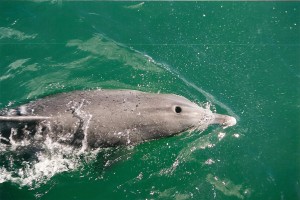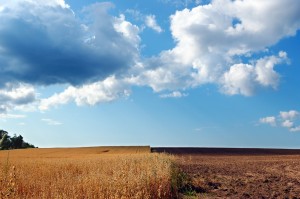Nieuw Worldlog Marianne Thieme
16 oktober was het Wereldvoedseldag. 57 Dagen na Earth Overshoot Day, de dag waarop we dit jaar de reproductiecapaciteit van de aarde overschreden en een nieuw ecologisch begrotingstekort van recordhoogte realiseerden. Op 16 oktober gingen er één miljard mensen met honger naar bed. Niet omdat er te weinig voedsel wordt geproduceerd. De aarde biedt genoeg voor ieders behoefte. Maar naast de één miljard hongerigen staan één miljard mensen die lijden aan overgewicht.
We kampen met een zeer scheve verdeling van voedsel en met vormen van roofbouw die nog in onze generatie gaan leiden tot ernstige schaarste aan onder meer drinkwater, fosfaat en biodiversiteit. Bovendien moeten we rekening houden met schaarste aan veevoer door misoogsten als gevolg van onze onachtzaamheid ten aanzien van het klimaat.
Onderzoek van de Universiteit van Minnesota gaf vorige maand aan dat er wel degelijk hoop is voor een groeiende wereldbevolking, op voorwaarde dat het beleid wezenlijk gewijzigd wordt. We zouden met het huidige akkerbouw-areaal ruim 10 miljard mensen kunnen voeden, op voorwaarde dat we de gewassen niet meer verspillen aan veevoer en biobrandstof.
De veehouderij neemt wereldwijd 80% van alle landbouwgronden in beslag. De overmatige dierlijke eiwitconsumptie en -productie veroorzaakt niet alleen ernstig overgewicht én dierenleed hier, maar tevens honger en verwoesting in de rest van de wereld. Nog steeds wordt er op grote schaal tropisch regenwoud gekapt voor de massale teelt van veevoer. De productie van vlees is daarmee verantwoordelijk voor 30% van het mondiale biodiversiteitsverlies.
In een studie naar de toekomst van de Nederlandse veehouderij wordt aangegeven dat onze leefstijl vier aardbollen vergt wanneer de rest van de wereld ons consumptiepatroon overneemt. Inzetten op gezonde landbouw, dicht bij huis, kan de grondstofkringlopen weer sluiten, onze voedselafhankelijkheid verkleinen en de wereld een duurzaam voorbeeld verschaffen. Een echt duurzame landbouw herstelt de verbinding tussen consument en voedselproducent, en zorgt dat boeren een eerlijke prijs krijgen voor een eerlijk product.
Het kabinet zal Nederland moeten aanzetten om mes en vork te zien als belangrijkste wapens in de strijd tegen klimaatverandering, biodiversiteitsverlies en dierenleed.
In mijn Worldlog van week 40 vertelde ik over het succes om de dolfijnenslachtingen op de Faeröer eilanden te stoppen. Deze week ook goed nieuws voor de dolfijnen in Japan. Onze motie, die de Nederlandse regering oproept om zich internationaal sterk te maken voor een einde aan de jaarlijkse massaslachtingen van dolfijnen bij Taiji (Japan), is aangenomen!
Elk jaar worden bij Taiji (en bij de Faeröer) duizenden wilde dolfijnen bij elkaar gedreven. Op barbaarse wijze worden de dieren gedood, uitmondend in één groot bloedbad. Japan heeft een groot aandeel in deze drijfjachten, om wilde dolfijnen voor veel geld te kunnen verkopen aan dolfinaria, zeeaquaria en toeristische programma’s voor het zwemmen met deze dieren. De overige dolfijnen, zo’n 23.000 dolfijnen per jaar, worden afgeslacht voor hun vlees.

Commerciële jacht op walvissen is illegaal, maar kleine walvisachtigen, waaronder dolfijnen, zijn nog altijd niet opgenomen in de bescherming van de Internationale Walvis Commissie (IWC). Dankzij onze aangenomen motie moet de regering nu inzetten op een verbreding van het beschermingsregime van de IWC, waardoor ook de jacht op de kleine walvisachtigen kan worden aangepakt.
Klik hier voor de trailer van de nieuwe film van the Blackfish. Deze film is een aanrader!
En kijk hier of lees hier over de prachtige actie van kunstenaar Banksy: Sirens of the Lambs!
Tot volgende week!
On 16 October it was World Food Day. 57 Days after Earth Overshoot Day, the day on which we exceeded the reproductive capacity of the earth this year and hit a new record ecological budget deficit. On 16 October one billion people went to bed with hunger. People are not hungry because too little food is produced. The earth offers enough for everyone’s needs. But next to those one billion hungry people are one billion people who suffer overweight.

We contend with a distorted division of food and forms of exhaustion, which, in our generation, will lead to scarcity of drinking water, phosphate and biodiversity among other things. Furthermore, we have to watch out for a possible shortage of cattle food due to poor harvests as a result of the neglect of our climate.
Research of the University of Minnesota showed us last month that there is definitely hope for a growing world population, on the condition that the policy will be substantially changed. With the current arable farming area we should be able to feed more than 10 billion people, provided that we do not waste harvests on cattle food and biofuel.
Cattle farming on a global basis takes up 80% of all agricultural lands. The excessive animal protein consumption and production do not only cause serious overweight and animal suffering here, but also hunger and destruction in the rest of the world. The tropical rain forest is still cut down on a large scale for the massive production of cattle food. As a result, the production of meat is accountable for 30% of the global biodiversity loss.
A study into the future of Dutch animal husbandry indicates that we would need four globes to fit our lifestyle when the rest of the world takes over our consumption pattern. Aiming for healthy agriculture, close to home, may close the raw materials cycle again, reduce our food dependency and give the world an example of good sustainability. A true sustainable agriculture will repair the connection between the consumer and the food producer and will ensure that farmers get a fair price for a fair product.
The government will have to encourage the Netherlands to consider knife and fork as the most important weapons in the fight against climate change, biodiversity loss and animal suffering.
In my Worldlog of week 40 I told you about the successful stopping of dolphin slaughter on the Faroe Islands. This week we also have some good news for the dolphins in Japan. Our motion, which calls the Dutch government to advocate internationally for an end to the annual mass slaughter of dolphins at Taiji (Japan), was adopted!
Each year thousands of wild dolphins are driven together at Taiji (and the Faro Islands). The animals are killed in a barbaric way, resulting in one big bloodbath. Japan has a great share in these drives, so that they can sell wild dolphins for a lot of money to dolphinariums, sea aquariums and touristic programmes for swimming with these animals. The other dolphins, approx. 23,000 dolphins per year, are slaughtered for their meat.

Commercial hunting of whales is illegal, but small cetaceans, including dolphins, have still not been included in the protection programme of the International Whale Commission (IWC). Thanks to our adopted motion the government now has to aim at expansion of the protection regime of the IWC, so that the hunting of small cetaceans can also be tackled.
Click here for the trailer of the new film of the Blackfish. This film is highly recommended!
And look here or read here about the wonderful action of artist Banksy: Sirens of the Lambs!
Until next week!